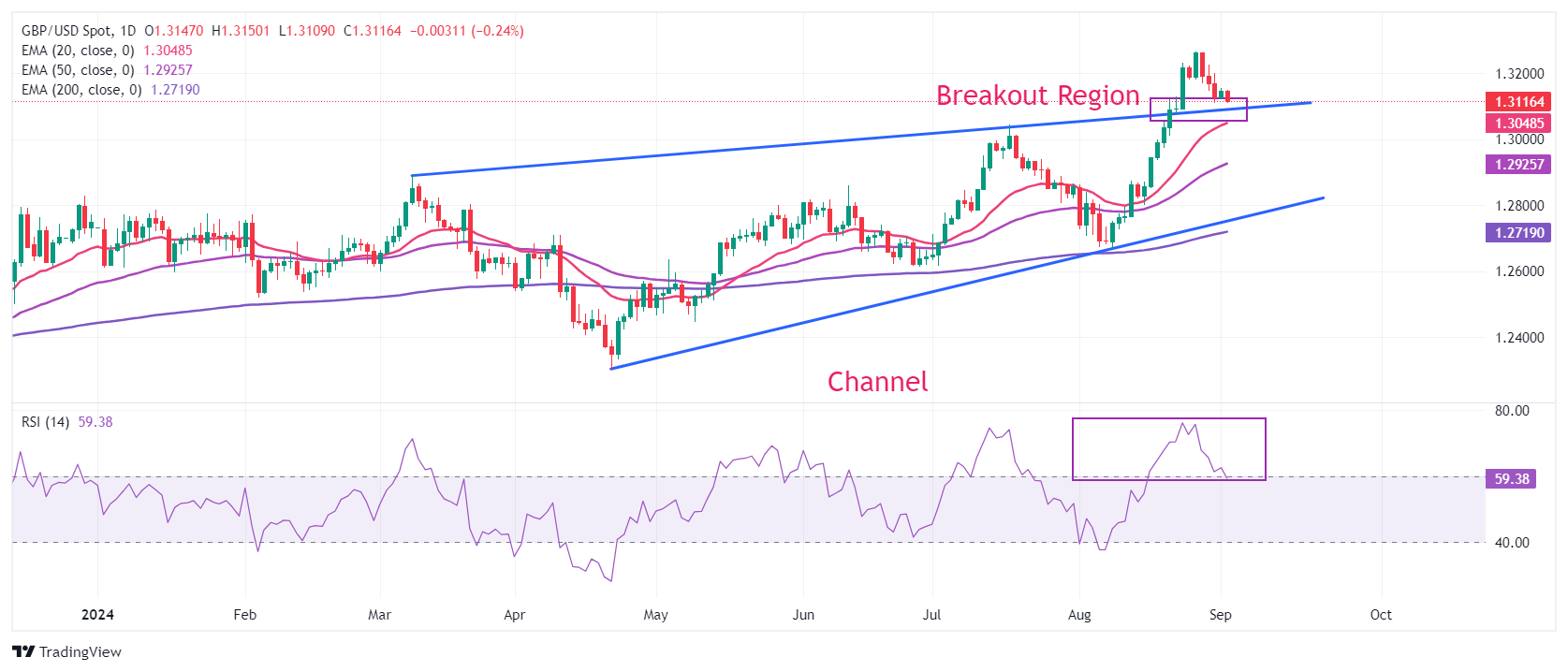Pound Sterling Drops Against US Dollar Ahead Of US Manufacturing PMI
The Pound Sterling (GBP) exhibits a subdued performance slightly above the crucial support of 1.3100 against the US Dollar (USD) in Tuesday’s London session. The GBP/USD pair edges lower as the US Dollar grips gains near an almost two-week high, with investors’ attention turning to the United States (US) Nonfarm Payrolls (NFP) data for August, releasing this Friday.
The US Dollar Index (DXY), which tracks the Greenback’s value against six major currencies, consolidates near 101.70.
Investors keenly await the labor market data as it is expected to drive market speculation for the magnitude of the Federal Reserve’s (Fed) interest rate cut this month. Currently, traders are split about whether the Fed will cut interest rates gradually by 25 basis points (bps) or aggressively by 50 bps.
The importance of the labor market data has increased significantly as comments from Fed Chair Jerome Powell at the Jackson Hole (JH) Symposium indicated that the central bank is more focused on preventing job demand, given that officials are confident about inflationary pressures remaining on track to sustainably return to bank’s target of 2%.
Investors will also get cues about the current labor market status from the US JOLTS Job Openings data for July and the ADP Employment Change data for August, which will be published on Wednesday and Thursday, respectively.
In Tuesday’s session, the US Dollar will be influenced by the S&P Global (final estimate) and ISM Manufacturing Purchasing Managers Index (PMI) data for August, which will be published in the North American session. Economists expect that activities in the manufacturing sector contracted at a slower pace, with the official PMI from the ISM coming in at 47.5 from July’s reading of 46.8.
Daily digest market movers: Pound Sterling falls despite BoE seems to be leaving interest rates steady at 5%
- The Pound Sterling performs weakly against its major peers, except Asia-Pacific currencies, during the European trading hours. The British currency remains on the back foot even though the Bank of England (BoE) is expected to follow a shallow interest rate cut cycle this year compared to its peer central bankers.
- Traders see little chance that the BoE will cut interest rates in September but are confident about November, Reuters reported. Market speculation for September interest rate cuts is weak as inflationary pressures in the United Kingdom (UK) are expected to remain sticky due to strong economic prospects. Also, comments from BoE Governor Andrew Bailey at the JH Symposium indicated that the central bank will be careful not to cut interest rates too quickly or by too much.
- The final estimate of S&P Global/CIPS Manufacturing PMI showed on Monday that activities in the manufacturing sector in the UK expanded to a 26-month high at 52.5 in August, driven by the continuation of a strong recovery in output, new orders, and labor demand.
- “The UK manufacturing sector remained a positive contributor to broader economic growth in August. The headline PMI hit a 26-month high of 52.5, reflecting solid expansions in output and new orders and the strongest jobs growth for over two years. The upturn is broad-based across manufacturing, with the investment goods sector the stand-out performer”, Rob Dobson, Director at S&P Global Market Intelligence, said.
- For fresh interest rate clues, investors await BoE policymaker Sarah Breeden’s speech, which is scheduled at 12:45 GMT. Breeden was among policymakers who voted for cutting interest rates in August by 25 basis points (bps) to 5%, along with Andrew Bailey, Swati Dhingra, Dave Ramsden, and Clare Lombardelli.
Technical Analysis: Pound Sterling sees support slightly below 1.3100
(Click on image to enlarge)
The Pound Sterling declines to nearly 1.3100 against the US Dollar. The GBP/USD pair faces pressure after declining below the round-level support of 1.3200 last week. The Cable may likely find buying interest near the breakout region of a Channel chart formation on a daily timeframe.
The 14-day Relative Strength Index (RSI) declines to near 60.00 after exiting overbought conditions, signaling a lack of bullish momentum at the moment.
However, upward-sloping short-to-long-term Exponential Moving Averages (EMAs) suggest a strong bullish trend.
If bullish momentum resumes, the Cable is expected to rise towards the psychological resistance of 1.3500 and the February 4, 2022, high of 1.3640 after breaking above a fresh two-and-a-half-year high of 1.3266. On the downside, the psychological level of 1.3000 will be the crucial support for the Pound Sterling bulls.
More By This Author:
EUR/USD Retreats As US Dollar Grips Gains Ahead Of US Manufacturing PMIXAG/USD Struggles Near $30 Amid Uncertainty Over Size Of Fed Interest Rate Cuts
AUD/USD Rally Stalls Near 0.6800 With Aussie Inflation In Focus
Disclaimer: Information on this article contains forward-looking statements that involve risks and uncertainties. Markets and instruments profiled on this page are for informational purposes ...
more



